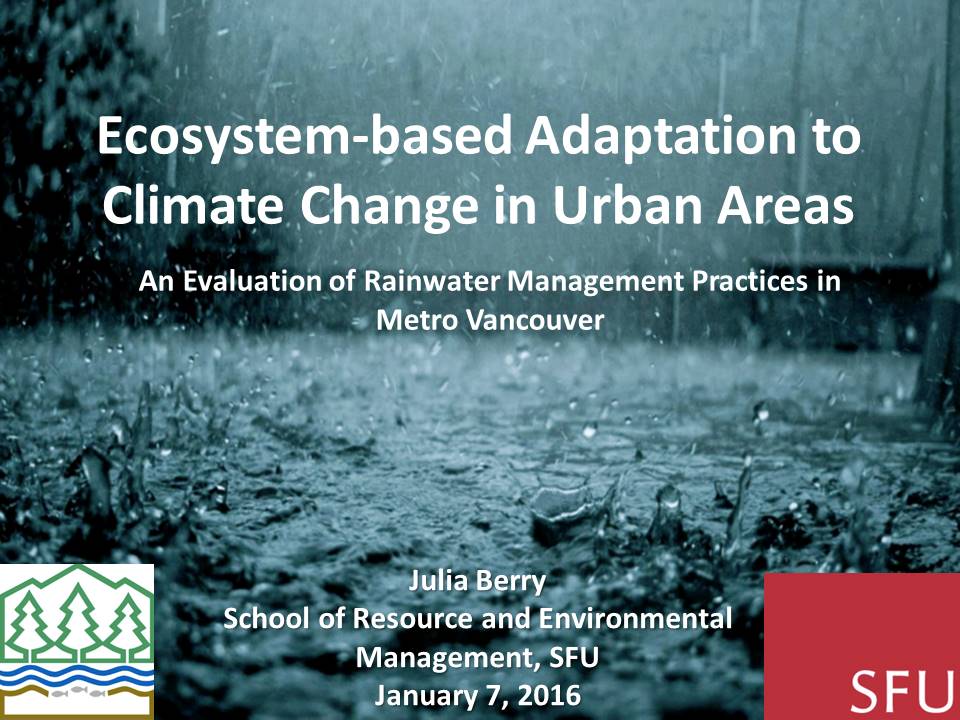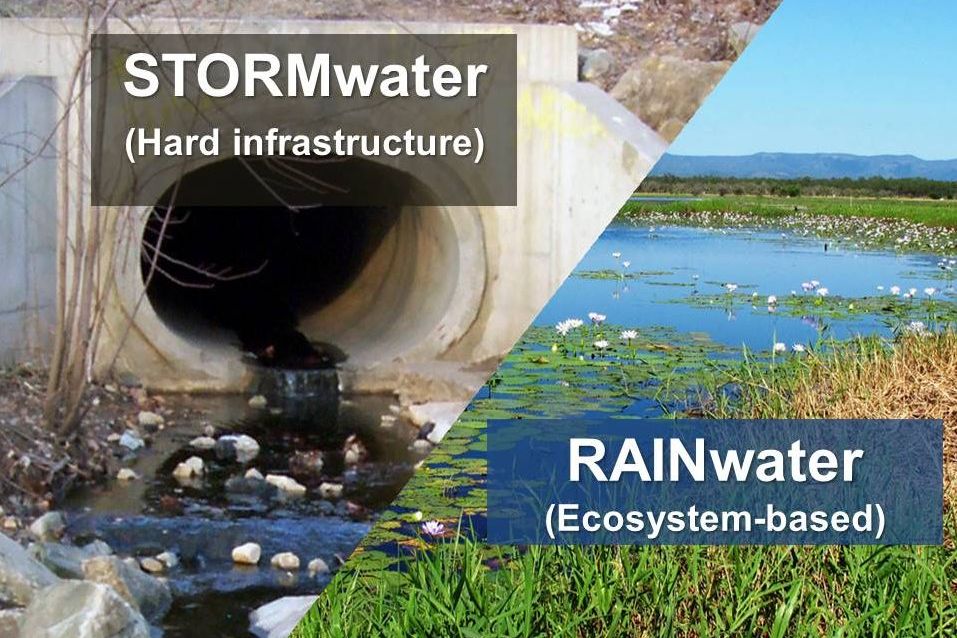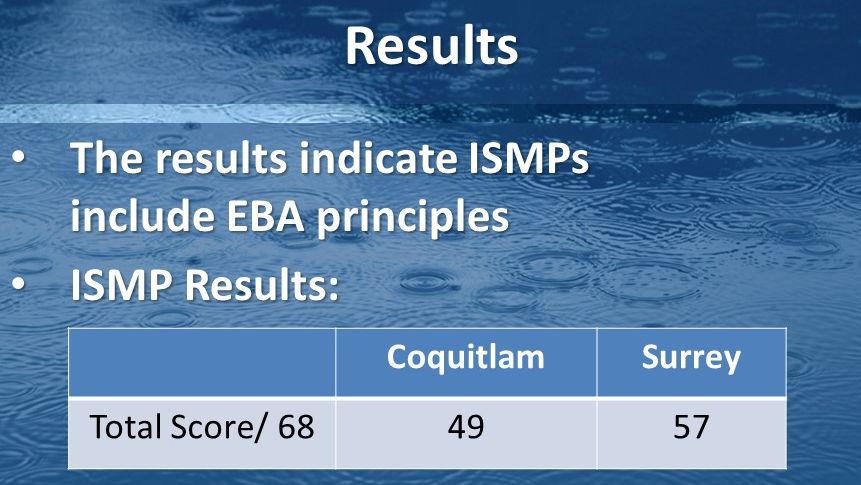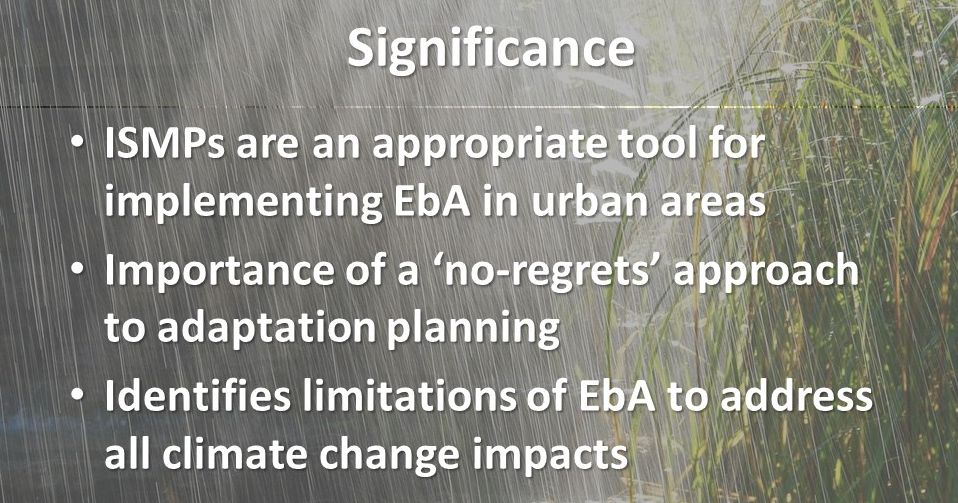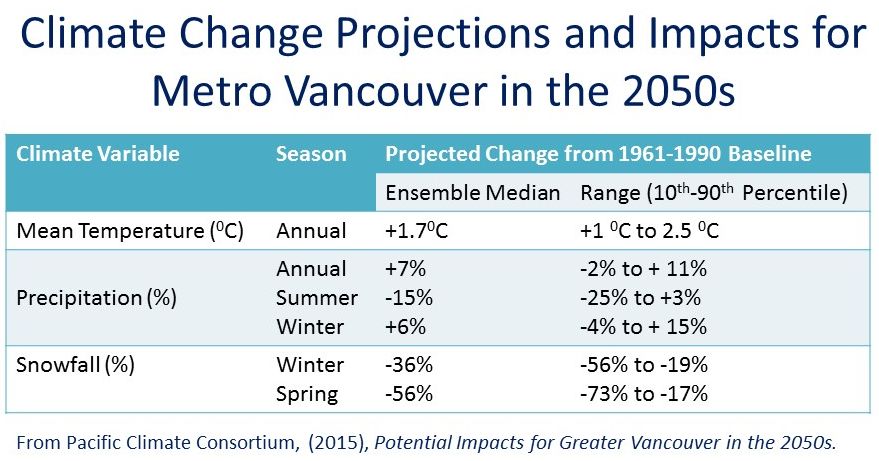Think and Act like a Watershed (Part 1): Harness Nature to Adapt to a Changing Climate
Note to Reader:
This is a 4-part series. Part 1 introduces new ecosystem-based adaptation (EbA) research in BC that may inspire a new generation to “think and act like a watershed”. Part 2 will celebrate the 20th anniversary of publication of the seminal research by Richard Horner and Chris May, University of Washington. Part 3 will showcase the results of recent rain garden research by Jennifer McIntyre at Washington State University. Part 4 will conclude with the parallel journeys of Washington State and British Columbia and how the Water Balance Methodology is the foundation for an ecosystem-based approach to protection of hydrologic integrity, and hence creek system resilience.
1st in a series connecting past and current research
Ecosystem-based Adaptation (EbA) – influence land use & infrastructure practices in urban watersheds
In the late 1990s water resource practitioners in British Columbia, who learned from Washington State research, embraced an “ecosystem-based approach” to integrated stormwater management planning. Although this interdisciplinary way-of-thinking underpinned Stormwater Planning: A Guidebook for British Columbia, released by the Province in 2002, use of the ecosystem term failed to take root in the drainage practitioner culture.
Two decades later, however, research undertaken at Simon Fraser University creates a window of opportunity to connect the present to the past, and build on historical knowledge and understanding to educate and inspire a new generation of practitioners to “think like a watershed”and implement ecosystem-based solutions.
Historical Context
In 1996, Richard Horner and Chris May (University of Washington) published their seminal research that correlated land use, cumulative impacts and stream health. Their findings shook conventional stormwater management wisdom in the Pacific Northwest to its foundation. Their work became part of the curriculum for cross-border sharing via a workshop series conducted by Bill Derry and Kim Stephens for local governments.
The workshops generated interest in the ecosystem-based approach and led to the SmartStorm Forums, four transformational events held between January 1999 and March 2001. Organized by a partnership comprised of federal, provincial and local governments, the SmartStorm Forums advanced an ecosystem-based approach to stormwater management. A notable outcome was Stormwater Planning: A Guidebook for British Columbia.
A Combination of Concepts
Fast-forward to May 2016. At a meeting of the Metro Vancouver Stormwater Interagency Liaison Group (SILG), a forum for local government representatives, Julia Berry presented the findings from her Master’s thesis. A graduate of the School of Resource and Environmental Management, Simon Fraser University (SFU), Julia Berry applied original thinking to apply core concepts and produce:
Ecosystem-based Adaptation to Climate Change in Urban Areas: An Evaluation of Rainwater Management Practices in Metro Vancouver
The core concept of the research project, EbA, is a combination of two other significant concepts: EBM (ecosystem-based management) and climate change adaptation. The value of the work by Julia Berry is two-fold: picks up threads from the 1990s; and reminds practitioners to focus on outcomes not output – What does the community want? What is the goal? How will actions restore hydrologic integrity?
The presentation was arranged by Kim Stephens, co-supervisor on the thesis committee for Julia Berry’s project. He is the Executive Director, Partnership for Water Sustainability in British Columbia.
To Learn More:
Download a copy of Ecosystem-based Adaptation to Climate Change in Urban Areas: An Evaluation of Rainwater Management Practices in Metro Vancouver, the project by Julia Berry.
Application of Evaluation Framework to Integrated Stormwater Management Plans (ISMPs)
 “Adapting to climate change will require a combination of approaches, from man-made infrastructure to holistic approaches. British Columbia’s Stormwater Planning Guidebook promotes a holistic approach to rainwater management, which views rain as a resource and aims to mimic the natural hydrological cycle by allowing rainwater to return directly to the ecosystem,” notes Julia Berry.
“Adapting to climate change will require a combination of approaches, from man-made infrastructure to holistic approaches. British Columbia’s Stormwater Planning Guidebook promotes a holistic approach to rainwater management, which views rain as a resource and aims to mimic the natural hydrological cycle by allowing rainwater to return directly to the ecosystem,” notes Julia Berry.
British Columbia’s Guidebook:
“In 2002, the Government of British Columbia (BC) updated traditional stormwater management regulation with the holistic approach outlined in the Guidebook. The ISMP guidelines cite the threats from climate change to aging stormwater infrastructure as one of many rationales for integrating land use planning and stormwater management.”
“The result of integrating land use planning and rainwater-stormwater management through ISMPs (also known as Watershed Blueprints or Integrated Watershed Management Plans) may provide an opportunity to integrate ecosystem-based solutions to climate change into ecologically focused rainwater management plans.”
Metro Vancouver Case Studies:
“Ecosystem-based adaptation (EbA) is a novel approach to planning and adaptation that prioritizes ecosystem services, enhancing biodiversity, as well as human health and wellbeing,” continues Julia Berry. “My research uses a framework of EbA principles to evaluate select watershed plans from the cities of Surrey and Coquitlam in the Metro Vancouver region.”
“While the intended purpose of Integrated Stormwater Management Plans (ISMPs) is not directly to address climate change, the results of my research show that these two municipalities are already successfully implementing the principles of EbA through ISMPs in the urban context,” concludes Julia Berry.
Case Study Results
“The case studies evaluated in this projected were decided through the initial interview process and literature review,” explains Julia Berry. “Metro Vancouver was selected as the region for the study because ISMPs are legislated for all member municipalities.”
“The City of Surrey and the City of Coquitlam were selected as case cities during the initial expert interview process. They were selected because both cities have complete and successfully implemented ISMPs, both cities are recognized as regional champions of the ISMP process, and both cities were willing to participate in the study.”
“The principles of EbA are inherently found in Surrey’s and Coquitlam’s ISMPs; therefore, ISMPs are useful for implementing EbA in urban areas. These results are not unexpected as the principles of EbA are well aligned with the intended outcomes of ISMPs.”
“While the process for developing ISMPs is place-based and is aimed at attaining desired outcomes as opposed to specific practices, the inclusion of EbA principles will also inherently be place-based and likely be reflective of the culture and development requirements of particular municipalities,” concludes Julia Berry.
A City of Coquitlam Perspective
“I am a convert,” stated Melony Burton, City of Coquitlam, after Julia Berry concluded her presentation. Melony is SILG Chair and is the City’s Supervisor, Infrastructure  Management. “My initial thought was that ISMP’s are not the right place to house climate change adaptation objectives. Primarily because ISMP objectives focus on balancing land development objectives with engineering and environmental objectives. Some ISMP objectives provide secondary benefits for climate change adaptation but were not planned explicitly with that in mind.”
Management. “My initial thought was that ISMP’s are not the right place to house climate change adaptation objectives. Primarily because ISMP objectives focus on balancing land development objectives with engineering and environmental objectives. Some ISMP objectives provide secondary benefits for climate change adaptation but were not planned explicitly with that in mind.”
“Julia’s work demonstrates how changing climate effects such as increases in the frequency and volume of rainfall in the winter or drier hotter, summers are significant influencing factors which should be considered along with land use, engineered drainage systems and the environment when developing ISMP’s. As such, the regional stormwater committee will be considering how to integrate ecosystem-based adaptations for climate change into an upcoming revision of the ISMP template.”
Assessment of the Thesis Committee
“We were very grateful to the numerous people who agreed to participate in Julia’s study. Their enthusiasm for the topic and their generosity to share their knowledge and experience was critical for the success of the research,” notes Sean Markey, Senior Supervisor, Thesis Committee. Dr. Markey is an Associate Professor in the School of Resource & Environmental Management, Simon Fraser University
Resource & Environmental Management, Simon Fraser University
“Julia did a great job of integrating concepts and testing the evaluation framework on her two case cities. Hopefully the work continues to advance our understanding of EbA – particularly how to make these concepts accessible and measurable to help guide and promote implementation”
Future Application of Evaluation Framework:
 “The research by Julia Berry provides rainwater and adaptation planners with an overview of EbA from principles to practice in British Columbia. The evaluation framework developed by Julia Berry can be used to assess and score the extent to which provincial, regional or municipal documents incorporate EbA principles. The value of her work is that it connects current research to past approaches that have been fallow for more than a decade,” concludes Kim Stephens.
“The research by Julia Berry provides rainwater and adaptation planners with an overview of EbA from principles to practice in British Columbia. The evaluation framework developed by Julia Berry can be used to assess and score the extent to which provincial, regional or municipal documents incorporate EbA principles. The value of her work is that it connects current research to past approaches that have been fallow for more than a decade,” concludes Kim Stephens.


